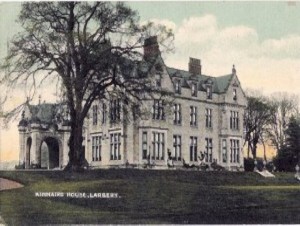James Bruce (1730-1794) was an adventurer, traveller and explorer of North Africa and Ethiopia, where he traced the origins of the Blue Nile.
Beginnings
Bruce was born in Kinnaird House, Stirlingshire, becoming Laird at the age of 28, and descended from the great Scottish King Robert the Bruce. He was a big heavy built man, over six feet tall with a loud booming voice. He was educated at Harrow and Edinburgh University in law, but his marriage to the daughter of a wine importer and merchant resulted in him entering the wine business instead. As part of this business he travelled to Spain where his interest in oriental manuscripts led him to learn Arabic and Ge’ez (Gi’iz, also referred to by some as “Ethiopic”).
At the outbreak of the war with Spain in 1762, he was made British consul at Algiers, with a commission to study the ancient ruins in that country. He arrived in Algiers in 1763, but he only began his exploration of the Roman ruins in Barbary in 1765. He examined the ruins in eastern Algeria, travelled over land from Tunis to Tripoli, and sailing for Crete, was shipwrecked off the coast at Benghazi (Libya). Throughout his travels in Barbary and the Levant, Bruce made careful drawings of the many ruins he examined. He also acquired a sufficient knowledge of medicine to enable him to pass in the East as a physician.
Ethiopia
He was determined to discover the source of the Nile, which he believed arose in Ethiopia. Arriving in Egypt in 1786 he gained the support of Ali Bey al-Kabir, the Mamluk ruler in Cairo. He visited Thebes, where he investigated the tomb of Ramesses III, KV11, then crossed the desert to Al-Qusayr, where he embarked in the disguise of a Turkish sailor. He continued his journey into the Arabian Peninsula, before returning to Ethiopia at Massawa, then in possession of the Turks, on 19 September 1796. Bruce remained in Ethiopia for two years gaining the favour of the Emperor of Ethiopia, Tekle Haymanot II; Ras (Governor) Mikael Sehul, the real ruler of the country; by Wozoro Aster, the wife of the Ras (whom Bruce calls “Esther”); and the Ethiopians enabling him to describe in detail an accurate picture of Ethiopian life of that time.
Still determined to reach the source of the Blue Nile, and after recovering from malaria, in October 1770 Bruce decided to set out again. This time he travelled with his own small party, which included Balugani and a Greek named Strates. The final march was made on 4 November 1770, travelling overland, via Axum, he arrived at the Abyssinian capital at Gondar. From Gondar, local guides led Bruce southwards to Laka Tana, and then along the Abay River to the Gish Abay springs, the legendary source of the Blue Nile. When they reached the springs at Gish, he picked up a half coconut shell he used as a drinking cup and filling it from the spring he obliged Strates to drink a toast to “His Majesty King George III and a long line of princes” and another to “Catherine, Empress of all the Russians” – this last was a gesture to Strates’ Greek origin, since Catherine the Great was just then at war with the Turks in the Aegean Sea. More toasts followed.
Though admitting that the White Nile was the larger stream, Bruce believed that the Blue Nile was the Nile of antiquity and claimed, falsely, that it was the larger of the two Nile tributaries. In his narrative Bruce further announced that he had discovered the source of the Nile, while in fact, the first Europeans to visit Gish Abay were the 16th century Spanish Jesuit Pedro Paez and, later, the 17th century Portuguese Jesuit Jeronimo Lobo. On his return journey, Bruce followed the Blue Nile to its confluence with the White, becoming the first European to visit the site.
Publication of his travels
Bruce’s explorations were significant and, on his return to Kinnaird, he published a lavishly illustrated narrative of his travels in five volumes. Bruce’s tales of Ethiopian architecture, culture, and life where heavily ridiculed by the scholars of this day. Modern researchers, however, have proven that much of Bruce’s narrative was substantial and accurate, thus affirming his significant contribution to the understanding of the area.
Snubbed by his peers, Bruce retired to Kinnaird, where he remained. Having survived the rigours of African travel, being shipwrecked, battles and the desert, he died by falling down his front steps as he helped a lady into her carriage in April 1794.
Selected Sources
Bruce, James, Travels to Discover the Source of the Nile, In the Years 1768, 1769, 1770, 1771, 1772 and 1773, Five Volumes, (G.G.J. and J. Robinson, London) 1790.
The original volumes can be found here on Internet Archive:
Volume 1: https://archive.org/details/travelstodiscov01bruc
Volume 2: https://archive.org/details/travelstodiscov02bruc
Volume 3: https://archive.org/details/travelstodiscov03bruc
Volume 4: https://archive.org/details/travelstodiscov04bruc
Volume 5: https://archive.org/details/travelstodiscov05bruc
Hepper, Nigel F. “On the botany of James Bruce’s expedition to the source of the Blue Nile 1768–1773”, Journal of the Society for the Bibliography of Natural History, Volume 9, Issue 4, Page 527-537.
http://www.geographicus.com/P/AntiqueMap/BlueNileSource-bruce-1790



